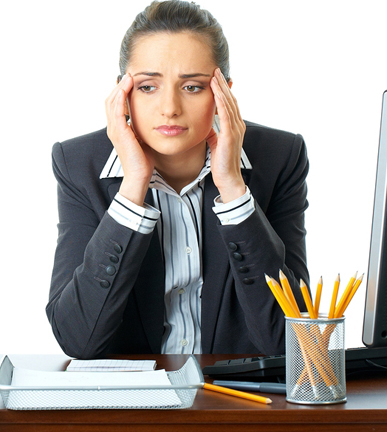Beating workplace stress
 We
often hear the word "stress" especially in relation to work. Most people
say they are stressed out at work due to the tight deadlines and
workplace pressures. This is an often overlooked aspect of workplace
health and safety. Workplace (physical) accidents are better known,
because there is more exposure on that issue. We
often hear the word "stress" especially in relation to work. Most people
say they are stressed out at work due to the tight deadlines and
workplace pressures. This is an often overlooked aspect of workplace
health and safety. Workplace (physical) accidents are better known,
because there is more exposure on that issue.
This year's World Day for Safety and Health at Work, which fell last
week (April 28) focused on this critical issue in the backdrop of many
workers facing greater pressure to meet the demands of modern working
life. It is an annual international campaign to promote safe, healthy
and decent work. It has been observed by the International Labour
Organization (ILO) since 2003. The date (28 April) has also long been
associated with the world's trade union movement's commemoration of the
victims of occupational accidents and diseases and is also tantalizingly
close to May Day, the biggest celebration of the working class.
Expectations
Psycho-social risks such as increased competition, higher
expectations on performance and longer working hours are contributing to
the workplace becoming an ever more stressful environment. Hence this
year's theme - "Workplace Stress: A Collective Challenge". In fact,
work-related stress is now generally acknowledged as a global issue
affecting all countries, all professions and all male and female workers
both in developed and developing countries. The impact of workplace
stress should not be underestimated, it accounts for 50-60% of lost
working days in any organisation according to the European Agency for
Safety and Health at Work. Workplace stress also leads to physical
problems (such as weight loss, weight gain, sleep loss, headcahes) and
mental problems (depression, lack of focus).
 Every
year some two million men and women around the world lose their lives
through accidents and diseases linked to their work. Working in
hazardous and stressful conditions is actually a daily, routine and
unseen affair for many workers. In addition, there are 270 million
occupational accidents and 160 million occupational diseases each year.
Four per cent of global gross domestic product, equivalent to an
astounding US$ 2.8 trillion, is drained off annually by costs related to
lost working time, interruptions in production, treatment of
occupational injuries and diseases, rehabilitation and compensation. Every
year some two million men and women around the world lose their lives
through accidents and diseases linked to their work. Working in
hazardous and stressful conditions is actually a daily, routine and
unseen affair for many workers. In addition, there are 270 million
occupational accidents and 160 million occupational diseases each year.
Four per cent of global gross domestic product, equivalent to an
astounding US$ 2.8 trillion, is drained off annually by costs related to
lost working time, interruptions in production, treatment of
occupational injuries and diseases, rehabilitation and compensation.
Injuries
Over 313 million workers suffer non-fatal occupational injuries each
year, equating to 860,000 people injured on the job daily. Every single
day, 6,400 people die from an occupational accident or disease. Every 15
seconds, a worker dies from a work-related accident or disease. Every 15
seconds, 160 workers have a work-related accident.
Work-related accidents or diseases can definitely be placed in the
high-burden category of all global health problems. However, fatalities,
accidents and illness at work are preventable if the right precautions
are observed. Wearing the right kind of safety clothing, from hard hats
to gloves, can make a difference. It also calls for a bit of discipline
from the workforce - for example, long hair and clothes which can get
entangled in machinery is generally taboo at many factories for obvious
reasons. Constant training on safety aspects is also essential.
Moreover, all workplaces, especially those with machinery of any
kind, should have someone in charge of safety, such as a Safety
Assurance Officer. They should also possess an on-call medical team and
an ambulance. This is a matter of life and death, because waiting even
five minutes for an outside ambulance could prove to be dangerous for
the victim.
Culture
According to the International Labour Organisation (ILO), all
countries must forge a national occupational safety and health culture.
"It is one in which the right to a safe and healthy working environment
is respected at all levels, where governments, employers and workers
actively participate in securing a safe and healthy working environment
through a system of defined rights, responsibilities and duties, and
where the highest priority is accorded to the principle of prevention,"
says the ILO.
While injuries and fatalities are commonplace in vocations such as
construction, mining, heavy vehicular transport, machinery operations
and industries, there are plenty of other vocations which are seemingly
safe but no less dangerous at least from the aspect of stress. Many
[white collar] professionals find their working environment extremely
challenging and stressful as their superiors have very high expectations
that may sometimes be not possible to achieve in a given time period.
Problems at home can affect one's performance at work as it is often
difficult to concentrate on work with other things in mind. It also
flows the other way - due to our 24/7 lifestyles and workplace demands,
it is often difficult to switch off completely from work even at home.
Thus it is very difficult for most people to mark a clear boundary
between home and office, which leads to more stress overall.
Challenge
Strange as it may seem, there are also people who thrive on the
challenge of workplace stress. These people say that as they near a
deadline the added pressure and stress may make them more focused and
creative. Thus a high-octane stressful environment can motivate some
people and increase productivity. However, it is important to channel
this energy in the proper way.
It is important for all organisations to accept the fact that
workplace stress exists and it is generally unhealthy, except in the
cases outlined above. It is not strictly necessary to have counselors or
psychiatrists on board, but superiors should have a chat with their
employees to identify any areas that may lead to stress and address
those concerns. Sometimes it might be a question of changing working
locations, patterns, times or processes that lessen the impact of stress
on individuals. A simple matter such as the lack of light can trigger
stress in an individual so organisations should look at the whole
picture.
Solution
It is also vital to support employees who may show signs of stress.
If they have someone they can talk with, it might lessen the impact.
Informal gatherings out of the office can also benefit these
stress-prone employees. In fact, the term "de-stress" has come into
vogue recently to describe various methods used to get away from stress.
Maintaining a healthy workplace with plenty of light and air and a
minimum of clutter is another suggestion often prescribed by de-stress
gurus. Also, why not encourage staffers to engage in meditation and
exercise for a few minutes every day, whether at home or another place
away from the office ?
There is no single solution for workplace stress and it cannot be
eliminated from our lives altogether in today's commercialized world.
But one can certainly reduce it through various means until it is no
longer an adverse factor for work and day-to-day life. A stress-free
workplace is a happier, snappier, more productive workplace. |

